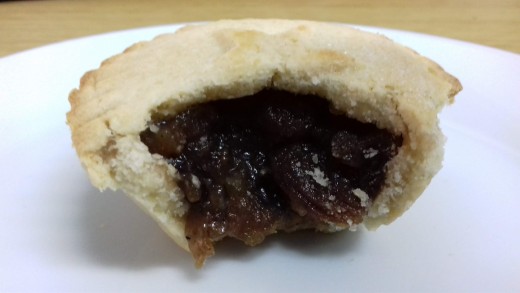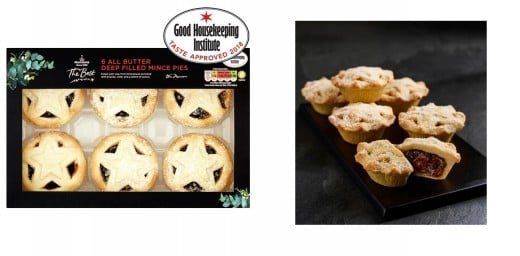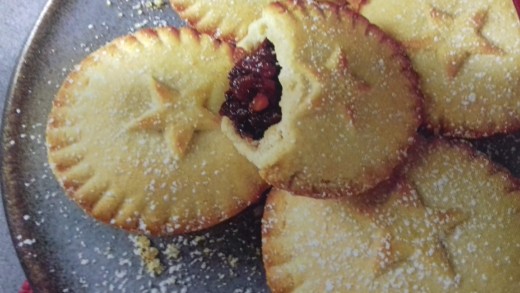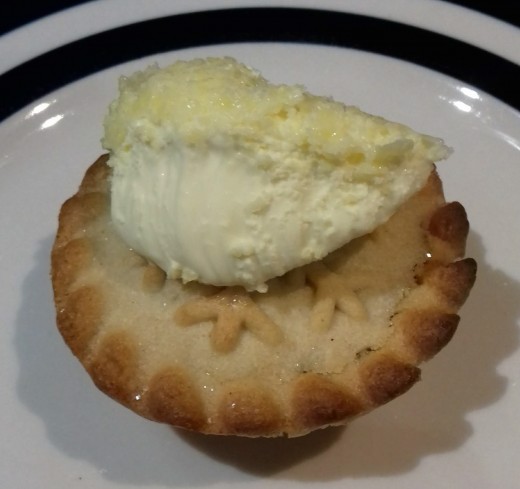The Mince Pie - A British Christmas Tradition

Brief History of the Mince Pie
The "Mince Pie" is a peculiarly British Christmas tradition. From mid November through to late December, British supermarket shelves are laden with boxes of these small cakes and it's estimated that annually, Britain consumes over 78 million during the festive period.
It's believed that the modern Mince Pie can trace it's history back to the 13th Century, when pilgrims and crusaders returned from the Middle East, with unfamiliar spices, such as cinnamon and nutmeg, which gradually found their way into regional recipes.
One of the first thoughts of many when they come across a "Mince" Pie for the first , is that "mince" is usually associated with meat? Although the word essentially means "mixture" , today's pie's are a sweet/savoury mixture with no meat, other than than the Suet, that is often used as an ingredient for the pastry. However this wasn't always the case, as original mince pies, and the recipes will have varied, but are thought to have been a mixture of sweet and savoury ingredients and likely have included shredded beef, rabbit, or mutton, along with honey, figs and various spices and like most things, the recipe has evolved to what we are familiar with today.
The seasonal "Spiced" Pie, due to it's ingredients, would have likely been the preserve of the more affluent in society. The pie itself, sometimes known as a Coffin, and similar to the Cornish Pasty, was more of a vestibule for the pie's contents and would be generally discarded , once the content was consumed.
The spiced pies during the late middle ages , through to the Tudor periods, by now known as "Shrid" or "Shred" pie, may not have been specifically a Festive tradition although their ingredients would have limited them to special occasions, rather than an everyday extravagance and it's said that Henry VIII, known for his abundant appetite, was particularly fond. The tradition continued through to Elizabethan and later, Jacobean era's, when they became known as "minched" pies, which may explain, their current moniker today.
Heading into the turbulent 17th Century, the pies had become smaller , although meat would still have been a regular ingredient and it is believed that during this period, the spiced pie would become more aligned and associated with the Christmas festive period. There has been a myth that had grown over the Centuries that the Lord Protector - Oliver Cromwell, governing Britain in the mid 17th Century, following his historic victory over the Royalist's in the bloody Civil War, that he and his Puritan brethren, managed to successfully "Ban" Christmas for a number of years, returning only with the restoration of the monarchy in 1660, however this apparently, was never the case, as is the myth, that the law was never repealed, and that the eating of mince pies is still illegal! Although a bill was pushed through Parliament by the Puriton's, it was never realised, although was certainly a curtailment of "shameful" festivities for a number of years and perhaps the humble mince pie , went underground for a while. By the late 1600's, the writings of the famous London Diarist, Samuel Pepys, confirm that the Mince Pie is very much now a Christmas tradition for many households and that Christmas simply would not be Christmas, without them.
It was during the early Victorian period of the early 1800's, along with the cheap imported sugar from the British Colonial controlled West Indies, that started to really see more familiar "sweet" pie become more desirable. The famous Mrs Beeton's Book of Household Management references a recipe for a "mincemeat" with brandy, raisins, apple, lemon juice, nutmeg ingredients, but still includes minced Beef, alongside more traditional versions, that would be more familiar today. Also, the practice was introduced of making the spices and fruit "mincemeat" months ahead and storing it in jars, along with brandy as a preservative and perhaps around this time, this caused a lesser inclusion of meat, as one of the main ingredients?

Religious Connotations
As with many widespread traditions, many get appropriated into the dominant religions of the time, and it is no surprise, that the Mince Pie was drawn into the British tradition and may also possibly explain it's intrinsic link to the British Christian Christmas celebration.
Various religious attachments have been attributed to the humble mince pie of the centuries, that there was originally 13 ingredients for the complement of apostles or that the three main spices - Cinnamon, nutmeg and cloves, are somehow linked to the three Magi, who visited Christ in the manger, but these are all hearsay. There are further links to the Manger and the spiced pie's gathering association to Christmas, in that around the late Middle Ages, the Pie would most likely been baked in a oval shaped vessel, giving the impression of a Manger, in some cases, a dough effigy of the baby Jesus would sometimes be added to the lid.
As mentioned previously, the 17th Century Puriton Parliament had an aversion to Christmas celebrations, as a link to "Popery" and Rome and although they managed to pass a bill to keep the markets open and not make the 25th December a holiday or special day, there was no specific mention of the Mince Pie in this act of Parliament, although there was some resistance in some parts of the country to this curb on a much loved time of the year, with even the residents of Canterbury in Kent rioting! An act that was to become known as the "Plum Pudding Riots"!


Quest for Excellence - The All Important Annual Reviews
Each year, usually around late October, the UK press and wider journalists will take in interest in the upcoming seasonal mince pies being sold at the major retailers. The reviews are of course, subjective and it is usual for a different victor each year and whilst there is usually a vast array from top-end premium versions from luxury London stores such as Harvey Nichols, Harrods and Fortnum and Masons, (sometimes costing up to £20/$25 a box!) somewhat surprisingly, it is often the budget end of the market, that often comes out top, which can't be a bad thing. Various media outlets usually provide an annual taste test, with the likes of the BBC Good Food, Lovefood.com, The Independenant and Which? Magazine usually providing results, the Good Housekeeping Magazine usually provide a good general yard stick, their 2018 taste test concluded the following result;
#3 Joint Runner Up - M&S "The Collection" 6 Mince Pies - Premium entry from the higher end of the British Supermarkets, these were retailing at around £2.50 ($3.24) a box. Judged for it's "crumbly, buttery pastry and flavoursome mincemeat, wide choice of fruit content and the pastry design, although a little let-down by the paleness of pastry in places, it was awarded 79/100. Interestingly, the BBC Food website, also voted Morrison's as the #1 for 2018!
#3 Joint Runner Up - Aldi "Specially Selected Range - 6 Mince Pies" - From the opposite end of the market, (from the German budget chain, which are slowly muscling in and applying huge pressure on the larger, more established British Supermarkets ). Costing only £1.35 ($1.75) a box, the judges liked the aroma of the pastry as well as the sweet tasting mincemeat, with subtle cinnamon tones and pleasantly sharp citric notes! They did comment however, that the softness of the pastry, made eating a slightly messy exercise.
#2 Second Place - Pret A Manger - Pret's Mince Pie - Widely referred to as "Pret", Pret A Manger are a British nationwide sandwich/coffee shop chain, (although their empire is rapidly expanding across the Globe!). Their Mince Pie was only available to buy in store, at a slightly pricey £1.49 ($1.93) each from the menu, but the G.H judges commented predominately on the excellence of the mincemeat flavouring, with "Zesty, tart flavours from the orange and lemon balance the sweet, juicy vine fruit", although a few of the judges did comment they found the flavouring a little overpowering!
The coveted #1 was taken this year by Morrisons "The Best" Mince Pies. (Morrisons originated as a Northern English Supermarket, tracing their origins back to 1899 in Bradford, Yorkshire, they are one of the top 6 supermarkets in the UK alongside Tesco, Asda, Sainsburys and more recently Lidl & Aldi). Costing just £2 ($2.59) a box, the judges scored them 83/100 and commented on the all round perfection of the aroma, mincemeat flavour and the perfection of the pastry! Worth noting that Iceland's "Luxury" range (which were also voted #5 for 2018 in Good Housekeeping's poll) were voted top by both The Independent newspaper and Lovefood.com as their #1 , so just goes to show the difference in voting and taste preferences!
Other notable mentions went to at #6 for Tesco's "Finest" at #7 for Mr Kipling Deep Filled Mince Pies.
in 2017 , the #1 pies were Marks & Spencer's (M&S) "Collection" (with both BBC Food, Which? & LoveFood.com crowning them top, Aldi also fared particularly well, being chosen as #1 by The Express and mentioned favourably in most of the years polls.
2016 saw budget supermarket Iceland's come out top on Lovefood.com, The Independent and Good Housekeeping, with Asda's "Extra Special" and Spar's "Luxury" Pies also coming out top. A vintage year for the budget brands, beating the premium pies in almost every category.
2019 results are starting to come in, with the BBC Good Food rating Morrison's All Butter Deep Filled Mince Pies as this year's #1 Mince Pie, with Sainsbury's Taste The Difference being highly commended. M&S scooped the award for best gluten free offering.
2020 results have thrown up a few surprises, Good Housekeeping and Which? Magazine have rated Iceland's "Luxury" All Butter Mince Pies highly, out of the big supermarkets, beating Sainsbury's "Taste The Difference" offering. Which? also commended Asda's "Extra Special" as outstanding and Tesco's "Finest" all butter faring well. Proving, once again, that the budget supermarkets can take on the likes of top end retailers, M&S and Waitrose, and beat them in the seasonal Mince Pie stakes!

Ingredients for the Perfect Mince Pie
Whilst perhaps the majority of people will buy their Mince Pies pre-made/pre-packed from shops, they are relatively simple to make, even simpler if you buy the mincemeat in a jar, which many recipes recommend, although I will include a recipe below for the the mincemeat itself.
For many, the pastry is the important part! Shortcrust or Puff? Both varieties can be purchased pre-made in supermarkets, but the homemade traditionalists, most would definitely opt for the shortcrust version.
For roughly 12 mince pies you'll need;
200g Plain Flour
125g unsalted butter
100g icing sugar
2 large egg yolks
Pinch of salt
Add the Plain flour, Butter (best chilled and cut into chunks) and a pinch of salt into a bowl or a food mixer. Mix up until the mix resembles breadcrumbs. Add the egg yolks along with a table spoon of water and carry on mixing until it forms a dough. Remove and wrap in cling film and put into refrigerator for about an hour.
As mentioned, most people would probably buy a jar of mincemeat, Robinson's are widely available, although many rate Sainsbury's "Taste the Difference" as the superior mincemeat currently.
If you are feeling adventurous and want to make your own mincemeat, then a general recipe is as follows, although it is really a case of personal taste, so you may want to add more fruit or alcohol!
350g Mixed Dried Fruit (Sultanas, Raisins etc)
200g Apples (Bramley or Cox's variety, ideally)
110g Candied peel , chopped finely
170g Soft Dark Brown Sugar
120g Chopped Almonds
110g Shredded Suet (substitute for vegetarian suet, if required!)
2 teaspoon mixed ground spice
1/4 teaspoon cinnamon (reduce if required, for more subtle flavouring)
1/4 teaspoon ground nutmeg (reduce if required)
Juice and grated zest of One Orange
Juice and grated zest of One Lemon
2 Tablespoons or Brandy
Simply mix all the ingredients, except the brandy into a bowl and leave, covered overnight in a cool dark place, to allow the flavours to to develop. When ready, place in an oven proof bowl or casserole, cover and cook for around 1.5 hours on a low heat (220F/100C/Gas Mark 0.5, or lowest setting). Once ready, allow to cool and stir in the brandy (plus any additional alcohol - Rum or Cointreau, if required, if you went them extra boozy) and stir a few more times. Once fully cooled, the content can be transferred to washed/sterilised jars for storage and should keep for months, if not years!
Finally, using two third of the pastry, roll out on a floured surface, as thin as you can, (about 4mm) and cut with a 7.5cm (3") cutter, cut into rounds and place each into a 12 hole lightly greased bun/patty tin. Cut out a further 12 pastry rounds, ideally with a 6cm (2.5") cutter. If you're feeling extra adventurous, you can "Lattice" the lids, for a slightly nicer presentation, however they should still look and taste as good with the full lids!
Use the 7.5cm rounds to line each in a 12-hole bun tin. Brush edges with some egg white. Now fill the pastry cups with the mincemeat, filling them up to the brim. Dampen the edges of the smaller 6cm rounds place them as lids on each of the pies, gently pressing around the edges to fully form the lids.
Brush each pie with milk and it's a good idea to make 2 or 3 incisions on the top lid (to prevent them exploding) . If you wish, you can further decorate the lids with pastry stars or cut out holly leaf patterns.
Set the oven to Gas Mark 6/200c/400f and bake for 25-30 minutes.
Check on them regularly they should turn a lovely golden brown. Remove them from the oven and cool on a wire tray.

Perfect Accompaniments
The Mince Pie can be eaten or presented in various ways. Many favour a light dusting of icing suger and they can be eaten cold and on their own, but personally I find them much more delicious when warm.
Custard or Vanilla Ice Cream are great additions, especially when the pies are warmed, although I find, especially as living down the West Country, in Devon that thick clotted cream is the best! Although it is all down to personal preference!

© 2019 Kieran Clarke








